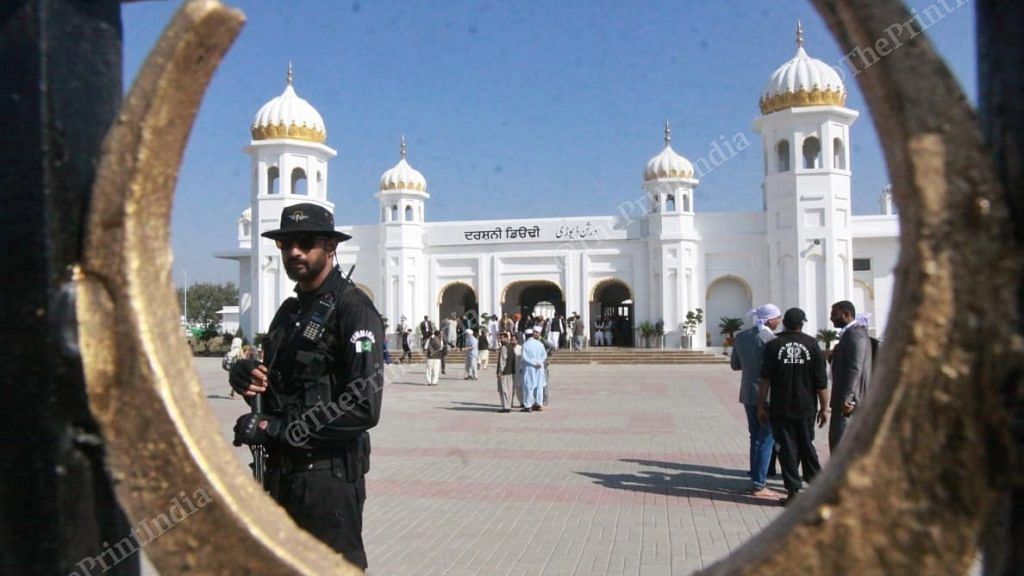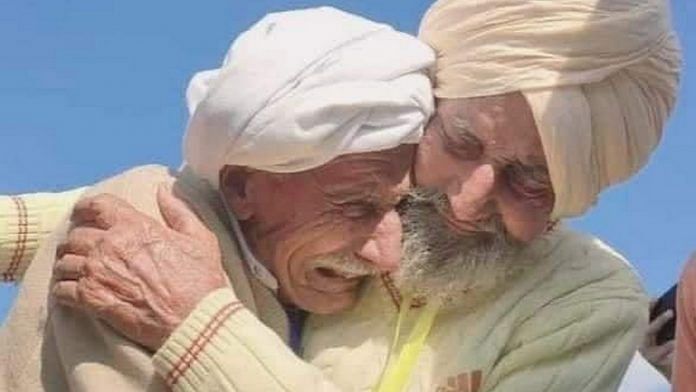Chandigarh: For 74 years, the two brothers had no idea about each other’s whereabouts or even if the other was still alive. Separated during the chaos of Partition, they had lost hope of reuniting until a video on Punjabi Lehar, a Pakistan-based YouTube channel, brought them together, from opposite sides of the India-Pakistan border, at the Kartarpur corridor connecting the two countries.
A video of the tearful reunion, showing the elderly brothers hugging each other, has now gone viral. The emotional meeting lasted just a few hours before the brothers returned to their respective homes.
The older of the two brothers, Saddiq Khan, was eight or nine years old during Partition, and currently lives in Bogran village (near Faisalabad) in Pakistan. Sheeka Khan was only a toddler at the time of the brothers’ separation and now resides in village Phulewala in Bathinda, Punjab. It was only after the reunion that Sheeka Khan learned that his given name was actually Habib Khan.
The emotional video of the two brothers meeting after all these years has tugged at the heartstrings of Punjabis around the world, some of whom still remember the harrowing Partition that gave rise to two nations and also created two Punjabs — Charda Punjab in India (towards the rising Sun) and Lehnda Punjab in Pakistan (towards the setting Sun).
Yet, despite the geopolitical split, the brothers could communicate perfectly with each other in Punjabi, using the same dialect. Saddiq Khan, who is the only one out of the two to have started a family, introduced his children, noohan (daughters-in-law), and pote-potian (grandchildren) to Habib.
Also Read: Let’s talk about Partition. We owe this debt to the dead and the displaced
A YouTube video, and some luck, brought brothers together
Nasir Dhillon and Lovely Singh run Punjabi Lehar — a popular YouTube channel that focuses on reuniting families from the two Punjabs — from Pakistan.
Dr Jagsir Singh, a resident of Phulewala who was involved in arranging the brothers’ meeting, told ThePrint that Dhillon and Lovely Singh had visited Bogran in May 2019 to conduct an interview for a story. This is when they learned about Saddiq Khan and his desire to meet his long-lost brother.
“The village lambardar (headman) is Saddiq’s nephew. He told [the film-makers] about Saddiq looking for his brother in India. Nasir immediately created a video message from Saddiq, in which he named the village Phulewala and that he was looking for his brother,” Jagsir Singh said.
Saddiq’s message in the video was short and sweet: “Habib, I have been looking for you for many years. If you can see me, please contact me. I am 80 years old and I don’t know how long I will live, but I really long to meet you.”
Within two days of being uploaded on Punjabi Lehar, the video rang a bell with one of Dr Jagsir’s relatives who lives in Jagraon and knew about the family of Saddiq and Habib. He sent the video to Dr Jagsir, who thought there was something familiar about the elderly man speaking.

“Habib is one of the few Muslims in the village. When I saw the video, I realised how similar Saddiq looked to Habib. I showed the video to Habib and he started crying. Then we made them talk to one another through a video call on the mobile phone,” Jagsir said.
In their first conversation with one another, Saddiq asked Habib about their mother, and learned that she had passed away decades earlier. Saddiq, on the other hand, told Habib about their father’s death. They also discussed various uncles and cousins.
“Tu shaadi nahi karayi (Did you not get married)?” Saddiq asked Habib. When he came to know that Habib had no land in the village and had lived in penury, he said over the phone, “Whatever I have here belongs to you.”
Habib told Saddiq that he too had tried to look for him. He and his cousins tried to contact people from across the border and send messages but nothing came of it.
“We in India and Nasir in Pakistan decided that we must make them meet at the Kartarpur corridor. They are so old and we would not have been able to forgive ourselves if something happened to them before they could meet,” Jagsir said.
The Kartarpur corridor is a 4.7-km-long drivable passage on the India-Pakistan border that allows Sikh pilgrims from India to visit Gurdwara Darbar Sahib in Kartarpur, Pakistan.
The meeting was fixed for March 2020, but was delayed due to the Covid lockdown, during which the Kartarpur corridor was also closed. “When it reopened, we brought him to meet his brother,” Jagsir said.
“How the two brothers finally found each other was fateful. It’s because of the glory of Waheguru. They met at Darbar Sahib at Kartarpur, and it is that Guru that should be given credit, and not us,” he added.
‘It was difficult not to cry’
In the video, as the brothers hug and sit down on the floor, Habib is heard saying, “Look we have finally met, and you wouldn’t believe it.” Saddiq then introduces his family to Habib. “My granddaughter says that I want this grandfather also to live with us,” he said.
The two brothers enjoyed a meal together, with Saddiq’s grandchildren also eating out of Habib’s plate.
“For those few hours, India and Pakistan had dissolved as two nations. It was so difficult not to cry,” Jagsir said.
“We must find a way of asking the government to allow you to come here and spend time with your family,” Saddiq is heard saying in the video.
And as the two brothers bid goodbye after their meeting, Saddiq would not let Habib go. “I will miss my bus,” Habib said. “No, no, you won’t. The bus can wait,” Saddiq insisted.
Both brothers hope they can meet again soon.
A series of tragedies
The story of the brothers’ separation, as well as the aftermath, is wrenching.
Saddiq, Habib, and their sister lived with their parents in a village in Jagraon near Ludhiana when Partition took place. When the disturbances and rioting began, their mother decided to visit her parents’ place in village Phulewala, about 45 km from Jagraon. She took Habib with her.
“He was in our mother’s lap then, he was so small,” recalled Saddiq in the first video posted on Punjabi Lehar in May 2019. Saddiq, however, was old enough to remember events vividly, he said.
Saddiq never saw his mother again. While she was still away, he and other family members were forced to leave Jagraon.
Saddiq’s father was killed during the journey and his sister, too, got separated from him. He was able to reunite with her years later.
“Saddiq’s sister did reach Pakistan and they managed to re-unite after two or three years. Saddiq grew in the care of his father’s brothers in village Bogran, where they got some land. Saddiq went on to get married and has a large family with sons and daughters and grandchildren,” Jagsir said.
Habib, too, had a difficult life. When his mother learned that her husband and two other children had gone missing, she was so distraught that she ended her own life by jumping into a canal. “Habib grew up in the care of his mother’s elder brothers. Like others in their family, he became a shepherd and daily wager,” Jagsir said.
When Habib — known as Sheeka in his village until Saddiq informed everyone about his given name — got too old to work, a family that he worked for “virtually adopted” him and let him live at their house. He also visits his cousins every day, Jagsir said.
“Habib never got married… for him Saddiq’s children and grandchildren are now a family he can call his own,” Jagsir added.
(Edited by Asavari Singh)
Also Read: Muslims left this Punjab village after Partition, Sikhs and Hindus look after their mosque






